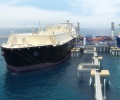

Japan’s Inpex-operated Ichthys project in Australia exported 26 cargoes of LPG up to early-October to key Asian buyers versus 29 shipments in the first 10 months of last year — supplying a steady stream from the new source since exports began in 2018, data from Platts cFlow trade-flow analytics software showed.
Shipments to buyers in Japan, China, Vietnam, South Korea, Indonesia and Taiwan over January-December 2020 totaled 34 cargoes, up from 27 in 2019 and four cargoes over April-December 2018, the data showed.
The Ichthys LNG project off northwestern Australia had some repair and maintenance work in early January 2021, but Inpex said production levels at the facility were maintained.
Inpex said in February, it planned to keep LNG and condensate shipments from Ichthys at a high level of around 120 LNG cargoes, 36 offshore condensate cargoes and 24 plant condensate parcels this year, though Japan’s top upstream company declined to disclose planned LPG shipments.
Of the LPG shipments so far this year, 13 cargoes were delivered to Japan and eight to China, the data showed. Of the shipments in 2020, 18 were delivered to Japan and 13 to China, according to the data.
The project involves piping gas from the offshore field in the Browse Basin more than 890 km (552 miles) to the onshore 8.9 million mt/year LNG plant near Darwin.
At its peak, the facility has capacity to produce 1.65 million mt/year of LPG and 100,000 b/d of condensate.
Stable production and shipments from the project is crucial as Japan steers towards using carbon-free LPG and Japan’s top LPG importer Astomos Energy has said it plans to start taking carbon-neutral propane from the Ichthys project this year.
This followed the signing of a sales and purchase agreement with Inpex Sept. 16. Inpex, which markets its equity share of Ichthys LPG and condensate output, has a separate sale and purchase pact with Astomos to supply Ichthys LPG, but the companies declined to comment whether the latest carbon-neutral propane supply is part of the Ichthys LPG supply.
Japan’s five major LPG importers aim to introduce 30,000 mt/year of carbon-free LPG in the early 2030s and replace their supply with “green LPG” to meet all LPG demand by 2050 under a new consortium.
Astomos, ENEOS Globe, Gyxis, Japan Gas Energy and Iwatani have formed the Institute of Japan Green LP Gas Promotion to introduce carbon-free LPG by developing a series of synthetic technological process known as propanation and butanation in Japan, executives from the companies said at a news conference Oct. 20.
Inpex and Ruwais in the UAE are Japan’s two main sources of carbon-free LPG, a Japanese trader said.
After loading at Ruwais, Astomos in August received from Shell Japan’s first 47,000 mt carbon-neutral LPG cargo at its Chiba import terminal.
Carbon credits
Chinese petrochemical makers consider the quality of LPG from Ichthys, especially from the gas field, suitable for use as petrochemical plant feedstock.
But the industry is not yet ready to include propane from Ichthys as an acceptable point of origin for the Ginga LPG Forward Terms 2021, following the final vote by 12 trading houses in 2020.
The Japanese trader said that Ichthys propane was also not included in the Ginga LPG Forward Terms 2022 contract. “It is one of the sources of carbon-free LPG, but it is not related to Ichthys to be included in Ginga 2022,” the trader said.
He added that for the carbon-free LPG concept to work, the supplier can also buy carbon credit from the market. “So I think any origin can be a candidate of the cargo,” he said.
However, Astomos President Tsuyoshi Ogasawara, who is also the chairman of the Institute of Japan Green LP Gas Promotion and Japan LP Gas Association, told the news conference that they remained uncertain whether verified carbon credits for carbon-neutral LPG will be considered carbon neutral in Japan, as the issue involves carbon pricing and carbon tax.
The industry’s move on carbon-neutral LPG comes as the government sees that 60% of the current domestic LPG will remain in 2050 because of its varied use in industry and as petrochemical feedstock.
And brokerage Poten & Partners said low inventory and the economic recovery from COVID-19 are expected to increase Japan’s 2021 LPG imports to 2019 levels at 10.8 million mt/year, up from 9.8 million/mt in 2020.
Upside potential for imports
The current forecast calls for about 2.8 million mt/year in Q4 2021, but “there is plenty of upside potential,” the report said.
Imports are forecast to grow further to 11 million mt/year in 2022 and hold around that level in 2023.
While imports may be higher than forecast if heating demand exceeds expectations, sourcing will be a problem even as Japan buys more from the US, Canada and Australia.
“As the rest of Asia imports grow, the share of LPG headed for Japan as opposed to the rest of Asia will decline,” the Poten report said.
Source: Platts